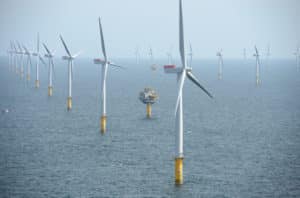Scientists, politicians and pundits warn us daily about the dangers of climate change and our over-reliance on fossil fuels. But when energy firms propose offshore wind turbine projects in the United States, lobbyists and regulatory agencies often hinder them. The promoters of Cape Wind learned this bitter lesson years ago. Are Vineyard Wind’s promoters encountering similar resistance today?
The ill-fated Cape Wind project would have placed 130 wind turbines generating 174 megawatts of electricity in the yachtsman’s playground known as Nantucket Sound. Well-funded opponents contested this project at every turn, in both regulatory agencies and the courts. Unable to withstand endless litigation, Cape Wind abandoned the project in 2017.
The Vineyard Wind project is more ambitious. It will consist of a wind farm 15 miles south of Martha’s Vineyard, with 84 turbines spread across 250 square miles. Underwater cables will carry clean electricity to a landfall in Barnstable, where buried cables will convey the electricity to an inland substation and into the power grid. The project is expected to generate 800 megawatts of electricity – enough for 400,000 homes – and reduce carbon emissions by more than 1.6 million tons per year. Vineyard Wind hopes to start delivering electricity in 2021, with the project fully operational in 2022.
Project Brings Millions of Dollars
The project will create thousands of new jobs and pay millions of dollars in mitigation fees. The full list of economic and environmental benefits is too lengthy to describe here, but a significant financing component depends on a generous federal clean energy tax credit that vanishes if construction does not commence in 2019.
Energy projects of this scale require scrutiny from government regulators and input from stakeholders. Commercial fishermen and seafood wholesalers have legitimate concerns about the project’s impacts, and Vineyard Wind plans to address them. Given the project’s benefits, one would think that government agencies at the federal, state, and local levels could collaborate to issue permits so construction can start this year, right? Wrong.
Massachusetts regulatory agencies and the town of Barnstable have worked diligently to issue approvals for Vineyard Wind. Vineyard Wind entered into a host community agreement with Barnstable in 2018. Last winter, the Massachusetts Secretary of Energy and Environmental Affairs certified the project’s environmental impact report. This certification finalized the Massachusetts Environmental Policy Act review process for the transmission cables within state boundaries and the substation in Barnstable.

Christopher Vaccaro
Opposition from Federal Regulators
However, the project recently encountered unexpected setbacks at the hands of the Edgartown conservation commission and the federal Department of Interior’s Bureau of Ocean Energy Management (BOEM). Vineyard Wind’s transmission cables will pass through an offshore area within the town of Edgartown’s jurisdiction. In July, the Edgartown conservation commission denied Vineyard Wind a wetlands order of conditions.
Vineyard Wind is appealing the denial to the Department of Environmental Protection, which is expected to issue a superseding order of conditions overruling the Edgartown conservation commission. However, project opponents are likely to challenge DEP’s superseding order in the Massachusetts courts, causing further delays.
The problems at BOEM are more troubling. The turbine array and miles of transmission cables will be installed in an area of the continental shelf under federal jurisdiction. This triggers the need for an environmental impact statement approved under the National Environmental Policy Act, and enhanced scrutiny by an alphabet soup of federal agencies.
Vineyard Wind hoped that its environmental impact statement would be approved last July, but was severely disappointed when BOEM decided this month to conduct a “cumulative impacts analysis” of the project. This analysis is expected to cause a cascade of delays to the project’s financing, supply chain, staging, and construction. The delays will jeopardize the clean energy tax credit’s availability and Vineyard Wind’s commitment to timely deliver electricity to utility companies. Massachusetts officials and members of Congress justifiably complained that Vineyard Wind is being held up by federal agencies that seem more friendly to the fossil fuel industry.
As of now, the biggest threats facing Vineyard Wind come from foot-dragging federal agencies led by a president who seems unconcerned about climate change and environmental protection. It would be disgraceful if the clock runs out on this worthy project, denying ratepayers affordable clean energy and stifling large-scale investments in the Massachusetts economy.
Christopher R. Vaccaro is a partner at Dalton & Finegold in Andover. His email address is cvaccaro@dfllp.com.









